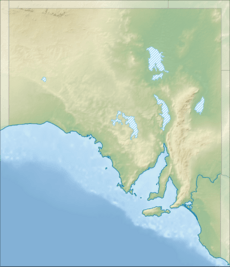Lake Hawdon South Conservation Park facts for kids
Quick facts for kids Lake Hawdon South Conservation ParkBray, South Australia |
|
|---|---|
|
IUCN Category VI (Managed Resource Protected Area)
|
|
| Nearest town or city | Robe |
| Established | 18 February 2010 |
| Area | 31.85 km2 (12.3 sq mi) |
| Managing authorities | Department for Environment and Water |
| See also | Protected areas of South Australia |
Lake Hawdon South Conservation Park is a special protected area in the Australian state of South Australia. It is located in a place called Bray. The park is about 280 kilometers (174 miles) south-east of the state capital, Adelaide. It is also about 18 kilometers (11 miles) east of the town of Robe.
This park was created to protect the unique environment around Lake Hawdon South. It helps keep the plants, animals, and special natural features safe for the future.
About Lake Hawdon South Conservation Park
What is a Conservation Park?
A conservation park is a type of protected area. It is a place where nature is kept safe. These parks help protect important plants, animals, and natural features. They also allow for some activities that use natural resources in a careful way. This park is managed by the Department for Environment and Water.
How the Park Was Created
Lake Hawdon South Conservation Park was officially created on 18 February 2010. It was set up under a law called the National Parks and Wildlife Act 1972. This law helps protect wild places in South Australia.
When the park was made, a special rule was also put in place. This rule allowed some activities like looking for oil or gas to continue. However, these activities must be done carefully to protect the park's nature. As of 2016, the park covers an area of 31.85 square kilometers (12.30 square miles).
The Lake and Its Plants
The park's borders match the size of a water body called Lake Hawdon South. This lake is a shallow lake that fills up with water at different times of the year. It is the southern part of a bigger lake system known as Lake Hawdon.
The lake has large areas of plants called sedgelands. These are wetlands with grass-like plants. Some of the important sedge plants found here include Gahnia trifida, Gahnia filum, Baumea arthrophylla, Baumea juncea, and Juncus kraussii. These plants are very important for the lake's ecosystem.
Special Nature of the Park
In 2010, experts described why this conservation park is so important. It has many special features that need protection:
- Special Living Things: The park is home to many important plants and animals. This includes 17 different types of animals with backbones. It also has seven special plant species and three unique plant communities.
- Rare Plant Groups: Two groups of plants in the park are considered vulnerable. This means they are at risk of disappearing. These are the Baumea juncea / B. arthrophylla sedgeland on the western side of the lake. The other is the Gahnia filum / G. trifida sedgeland.
- Ancient Living Rocks: The park contains a large area of special structures called thrombolites. These are like living rocks formed by tiny microbes over thousands of years. They cover an area of about 3.20 square kilometers (1.24 square miles).
- Animal Life: About 100 different native animal species live in the park. This includes animals like the western grey kangaroo, wombat, and bush rat. There are also eight types of amphibians (like frogs) and 15 types of reptiles (like lizards and snakes). One special reptile is the glossy grass skink, which is endangered in South Australia.
Park Classification
Lake Hawdon South Conservation Park is classified as an IUCN Category VI protected area. This means it is a protected area where natural resources can be used sustainably. This type of park aims to protect ecosystems and habitats. It also allows for some activities that support local communities, as long as they don't harm the environment.


